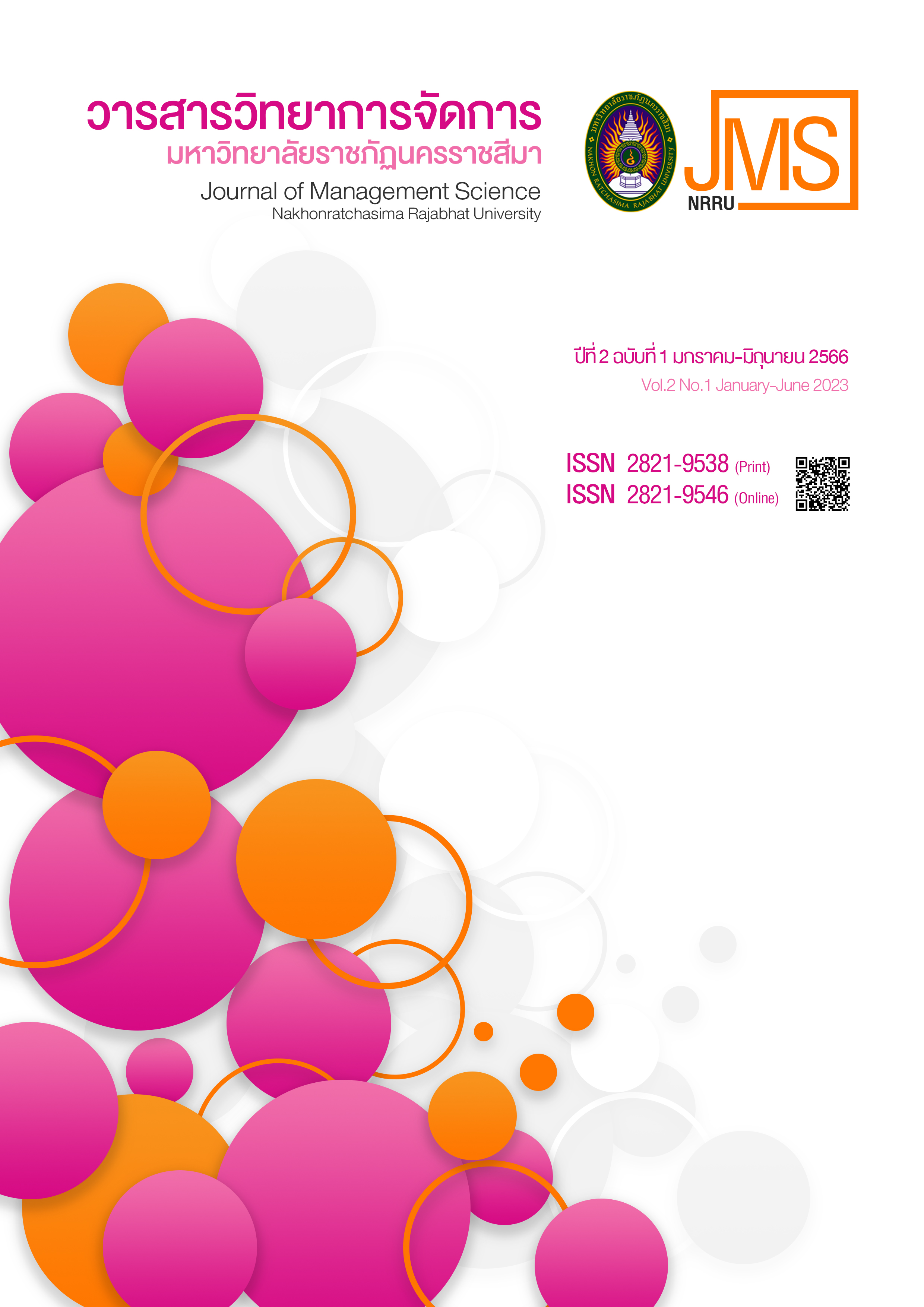Demand for creative tourism of Thai tourists Generation Y towards the creative economy Ayutthaya province after the epidemic of COVID-19
Main Article Content
Abstract
A Study of Creative Tourism Needs and Development Strategies of Thai Generation Y Tourists towards the Creative Economy Ayutthaya after the COVID-19 epidemic. The purpose of this study is to study the demand for creative tourism to the creative economy of tourists which collected data from a questionnaire with a group of 400 generation Y tourists using a random sampling method. It was found that most of the tourists were female, aged 21-30 years old, single status, undergraduate education, occupation student/student, income between 5,001-10,000 baht. As for the demand for creative tourism, it was found that the total demand for tourists was at a high level. The tourists had the highest level of demand for tourism activities in terms of local food tasting (Testing), followed by the aspect of visiting the community way of life (Seeing), and learning about local handicrafts (Learning), and Shopping at the souvenir Shop (Shop), respectively. When analyzing the regression equations, it was found that the model had a predictive accuracy of 69.3%. However, most suggestions would like to have a place to stay that is convenient to stay. Including the provision of food that is correct and hygienic. There is publicity for tourist attractions and tourism activities. Including signs for tourist attractions and the use of technology to allow tourists to access information more thoroughly.
Article Details

This work is licensed under a Creative Commons Attribution-NonCommercial-NoDerivatives 4.0 International License.
บทความในวารสารเป็นลิขสิทธิ์ของวารสารวิทยาการจัดการ มหาวิทยาลัยราชภัฏนครราขสีมา
บทความที่ปรากฎในวารสารเป็นความคิดเห็นของผู้แต่งเพียงอย่างเดียวซึ่งไม่เกี่ยวข้องกับวารสาร
References
กรมการท่องเที่ยว. (2562). คู่มือการประเมินมาตรฐานคุณภาพแหล่งท่องเที่ยวทางวัฒนธรรม. กรุงเทพฯ : กระทรวงการท่องเที่ยวและกีฬา.
กรมการปกครองกระทรวงมหาดไทย. (2561). ระบบสถิติทางทะเบียน ประจำเดือนธันวาคม 2661. [ออนไลน์]. แหล่งที่มา : http://stat.dopa.go.th/stat/statnew/upstat_age_disp.php. [25 ธันวาคม 2561].
ธานินทร์ ศิลป์จารุ. (2563). การวิจัยและวิเคราะห์ข้อมูลทางสถิติด้วย SPSS และ AMOS. กรุงเทพฯ :
บิสซิเนสอาร์แอนด์ดี.
นนทวรรณ ส่งเสริม. (2561). การท่องเที่ยวเชิงสร้างสรรค์. คณะมนุษย์ศาสตร์และการจัดการการท่องเที่ยว มหาวิทยาลัยกรุงเทพ.
บุญเลิศ จิตตั้งวัฒนา. (2557). การพัฒนาการท่องเที่ยวแบบยั่งยืน : การวางแผนการท่องเที่ยวอย่างยั่งยืน.
พิมพ์ครั้งที่ 2. [ฉบับปรับปรุง]. กรุงเทพฯ : ธรรมสาร.
ภัทรพงศ์ อินทรกำเนิด และคณะ. (2553). รายงานการวิจัยเรื่อง ระบบนวัตกรรมรายสาขาเพื่อพัฒนาระบบเศรษฐกิจฐานความรู้และเชิงสร้างสรรค์. กรณีศึกษาอุตสาหกรรมท่องเที่ยวเชิงสร้างสรรค์. สำนักงานเลขาธิการสภาการศึกษา กระทรวงศึกษาธิการ.
วนิดา เลิศพิพัฒนานนท์. (2561). “รูปแบบพฤติกรรมและแรงจูงใจในการท่องเที่ยวของคนไทย Gen Y.”
วารสารดุสิตธานี. 12(Special) : 134-149.
สมเดช รุ่งศรีสวัสดิ์. (2558). รายงานการวิจัยเรื่อง การพัฒนาแหล่งท่องเที่ยวบนฐานเศรษฐกิจสร้างสรรค์และการมีส่วนร่วมของชุมชนอย่างยั่งยืนกรณีศึกษา ต.คลองโคน อ.เมือง จ.สมุทรสงคราม. สถาบันวิจัยและพัฒนามหาวิทยาลัยราชภัฏสวนสุนันทา.
สาธิญา รุ่งพิพัฒนพงศ์. (2557). องค์ประกอบของความยั่งยืนของการท่องเที่ยวเชิงสร้างสรรค์ : กรณีศึกษาชุมชนอัมพวา จังหวัดสมุทรสงคราม. วิทยานิพนธ์ปริญญามหาบัณฑิต. สาขาวิชาพัฒนามนุษย์และสังคม บัณฑิตวิทยาลัย จุฬาลงกรณ์มหาวิทยาลัย.
สำนักนโยบายและแผน สำนักงานบริหารและพัฒนาองค์ความรู้. (2559). New gen is now: คนรุ่นใหม่คือพลัง
แห่งอนาคต. พิมพ์ครั้งที่ 2. สำนักนโยบายและแผน สำนักงานบริหารและพัฒนาองค์ความรู้.
สุดแดน วิสุทธิลักษณ์ และคณะ. (2554). รายงานวิจัยฉบับสมบูรณ์โครงการต้นแบบการท่องเที่ยวเชิงสร้างสรรค์ (Creative Tourism Model). องค์การบริหารการพัฒนาพื้นที่พิเศษเพื่อการท่องเที่ยวอย่างยั่งยืน (องค์การมหาชน).
องค์การบริหารการพัฒนาพื้นที่พิเศษเพื่อการท่องเที่ยวอย่างยั่งยืน. (2561). คู่มือกระบวนการพัฒนาและยกระดับกิจกรรมท่องเที่ยวเชิงสร้างสรรค์. กรุงเทพฯ : บริษัท บุ๊คพลัส พับลิชชิ่ง จำกัด.
Cochran, W.G. (1977). Sampling Techniques. 3rd ed. New York : John Wiley and Sons Inc.
Likert, R. (1967). “The Method of Constructing and Attitude Scale”. In Fishbeic, M (Ed.), Attitude Theory and Measurement. (pp. 90-95). New York: Wiley & Son.
Richards, G. and Wilson, J. (2006) “Developing creativity in tourist experiences : a solution to the serial reproduction of culture?” Tourism Management. 27 (6) : 1408-1413. อ้างถึงใน สาธิญา รุ่งพิพัฒนพงศ์. (2558). “องค์ประกอบของความยั่งยืนสําหรับการท่องเที่ยวเชิงสร้างสรรค์ : กรณีศึกษา ชุมชนอัมพวา จังหวัดสมุทรสงคราม.” วารสารศิลปศาสตร์ มหาวิทยาลัยอุบลราชธานี. 11(2) :
-140.
Tourism Authority of Thailand. (2016). “Keep Calm and Understand Gen Y”. TAT Review. : 32 – 37.
World Tourism Organization. (2017). UNWTO Annual Report 2016. UNWTO. Madrid. DOI [ออนไลน์]. แหล่งที่มา : https://doi.org/10.18111/9789284418725. [20 ธันวาคม 2561].


